All posts by Andrea Grant
About Andrea Grant
Andrea Grant is a Children's Services Specialist. View all posts by Andrea Grant →
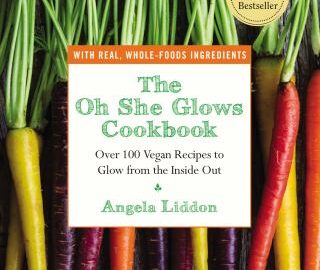
Bibliobites in January: V is for Vegan
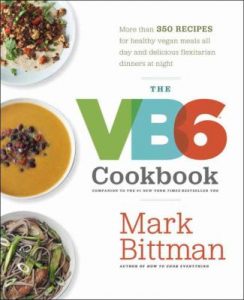 When you hear the word “vegan,” what comes to mind? Do you picture that old stereotype of an aging hippie hunched over a bowl of brown rice and vegetables? Or do you imagine Brooklyn hipsters scarfing down kale chips at a trendy bistro? Maybe it’s Tom Brady you think of, who credits an almost-vegan diet with being one of the keys to his playing longevity. Or perhaps you know someone who’s ethically opposed to eating animals in any form; or you have a friend, neighbor, or sibling who’s committed to a plant-based diet because of health or environmental concerns. While being a vegan isn’t quite a mainstream choice, it’s no longer “out there” as it was even five years ago. For evidence of this burgeoning trend, look no further than the library’s catalog, which lists 67 titles about vegan cooking! This month, our group experimented with the world of meat- and dairy-free cooking with two titles: The VB6 Cookbook by the prolific Mark Bittman, and The Oh She Glows Cookbook by blogger Angela Liddon.
When you hear the word “vegan,” what comes to mind? Do you picture that old stereotype of an aging hippie hunched over a bowl of brown rice and vegetables? Or do you imagine Brooklyn hipsters scarfing down kale chips at a trendy bistro? Maybe it’s Tom Brady you think of, who credits an almost-vegan diet with being one of the keys to his playing longevity. Or perhaps you know someone who’s ethically opposed to eating animals in any form; or you have a friend, neighbor, or sibling who’s committed to a plant-based diet because of health or environmental concerns. While being a vegan isn’t quite a mainstream choice, it’s no longer “out there” as it was even five years ago. For evidence of this burgeoning trend, look no further than the library’s catalog, which lists 67 titles about vegan cooking! This month, our group experimented with the world of meat- and dairy-free cooking with two titles: The VB6 Cookbook by the prolific Mark Bittman, and The Oh She Glows Cookbook by blogger Angela Liddon.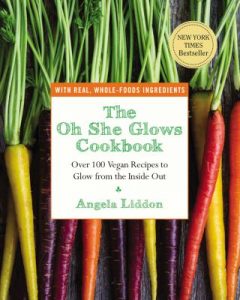
To begin our meeting, I asked everyone to describe the month’s experiences with one word. As always, opinions were forthright and varied wildly: “unsatisfying;” “boring;” “interesting;” “just….no;” “healthy;” “unappetizing;” “surprising;” and “surprisingly good.” Those strongly in the negative fell into a few camps: some do not like beans, or live with those who refuse to eat them. Others could not fathom purposely eliminating the “good stuff,” like cheese or meat; and some have dietary restrictions that already complicate meal planning, so adding the changes veganism requires is difficult or not advisable. But despite misgivings, most people persevered, and some discovered recipes that they’d be happy to include in their regular rotation.
Bittman’s book addresses some concerns regarding giving up favorite foods with his VB6 diet plan, in which participants are vegan-only before 6 PM, but eat omnivorously for dinner. Accordingly, the book has recipes of both types; but in general no one was impressed with this title. Orange soup with black salsa was “OK,” though the vegetable stock used in it was quite good. Both the African-style chicken stew and red paella with scallops didn’t seem to have enough seasoning and were “bland,” and ham hash with greens similarly lacked oomph. 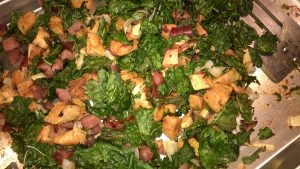 Spaghetti with bean Bolognese had an appropriately thick sauce, and overall was an enjoyable dish; but the cauliflower Romesco was just “OK,” while the eggplant meatballs were not a hit. They held together well but the proportion of breadcrumbs was too high, and were therefore over-evident in the final dish. The meatballs were served with all-purpose tomato sauce, which was “good,” but nothing out of the ordinary. The ribollita soup, a traditional Tuscan dish, was “really good,” and the sweet potato shepherd’s pie was a tasty version of this classic casserole.
Spaghetti with bean Bolognese had an appropriately thick sauce, and overall was an enjoyable dish; but the cauliflower Romesco was just “OK,” while the eggplant meatballs were not a hit. They held together well but the proportion of breadcrumbs was too high, and were therefore over-evident in the final dish. The meatballs were served with all-purpose tomato sauce, which was “good,” but nothing out of the ordinary. The ribollita soup, a traditional Tuscan dish, was “really good,” and the sweet potato shepherd’s pie was a tasty version of this classic casserole. 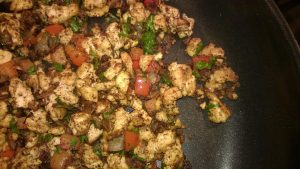 Chorizo tacos featured tofu subbing for the sausage; it was better than expected but “not a keeper.” Banana-chocolate ice cream was much better than expected, and was a creamy treat. This dessert is based on frozen bananas; one tip mentioned was to peel the bananas before you freeze them, since it’s way more difficult to peel them once they’re frozen. Also, this is one recipe for which you must have a food processor or a powerful blender. You could top your ice cream with coco-oat-nut granola, which was good and easy to make.
Chorizo tacos featured tofu subbing for the sausage; it was better than expected but “not a keeper.” Banana-chocolate ice cream was much better than expected, and was a creamy treat. This dessert is based on frozen bananas; one tip mentioned was to peel the bananas before you freeze them, since it’s way more difficult to peel them once they’re frozen. Also, this is one recipe for which you must have a food processor or a powerful blender. You could top your ice cream with coco-oat-nut granola, which was good and easy to make.
Liddon’s “Oh She Glows Cookbook” gets my vote for “worst name ever for a cookbook” (and blog for that matter), but obviously this doesn’t bother her legions of fans around the world. There were hits and misses from this title as well, but those who used it were mostly pleasantly surprised by how much they enjoyed what they tried. Maple-cinnamon apple & pear baked oatmeal made a delicious and hearty breakfast; it can be made ahead, always a plus. Present glo bars were a no-bake granola bar that include puffed rice cereal, which makes for a lighter, crispier bar. The bars were tasty but tended to fall apart once outside of the refrigerator, so they’re not as portable as you might hope.  10-spice vegetable soup with cashew cream, despite the enticing name, turned out to be your basic vegetable soup, but the Indian lentil-cauliflower soup was excellent, with a nice combination of spices. You could accompany your soup with spiced toasted pita chips, which were flavorful and not overly spicy. Lentil-walnut loaf was surprisingly delicious; it had a balsamic-apple glaze which seemed to have a weird combination of ingredients– but it turned out to be a perfect accent for the loaf. Other keepers were the crowd-pleasing Tex-Mex casserole,
10-spice vegetable soup with cashew cream, despite the enticing name, turned out to be your basic vegetable soup, but the Indian lentil-cauliflower soup was excellent, with a nice combination of spices. You could accompany your soup with spiced toasted pita chips, which were flavorful and not overly spicy. Lentil-walnut loaf was surprisingly delicious; it had a balsamic-apple glaze which seemed to have a weird combination of ingredients– but it turned out to be a perfect accent for the loaf. Other keepers were the crowd-pleasing Tex-Mex casserole, basically a vegan version of a taco casserole; and the soul-soothing African peanut stew (note to Mark Bittman: this one is really good!).
basically a vegan version of a taco casserole; and the soul-soothing African peanut stew (note to Mark Bittman: this one is really good!).
Liddon has a newer book as well, Oh She Glows Every Day, and one person tried it out. Again, there were some recipes that missed the mark; but there was still a lot to like. The fastest sprouted steel-cut oatmeal was a make-ahead breakfast; similar to other “overnight oats” recipes, you soak your oats overnight to speed up the morning’s cooking. We’re not sure if this is really sprouting your oats, but it’s a good technique anyway. The berry chia seed jam was a clever use of the thickening power of these seeds, and was a quick way to make a small batch of jam. The jam came in handy for the strawberry oat crumble bars, which were “surprisingly good.” Chia seeds also came into play in coconut chia seed pudding, but in this case the result was “yuck!” The texture of the chia seeds in this recipe was unpleasant and overwhelming. And though the lemon-tahini dressing wasn’t enjoyable, the Thai almond butter sauce was addictive– as advertised! 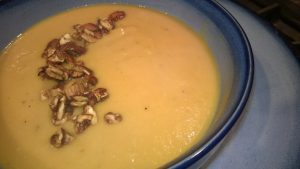 Creamy Thai carrot sweet potato soup was flavorful, but what really made this dish was its garnish of salty, crunchy roasted tamari almonds. One general complaint about the book’s salad recipes is that they frequently feature several ingredients that require advance prep; if you like this type of cooking (and have the time) it works well, but it’s not so good when you’re looking for a last-minute meal.
Creamy Thai carrot sweet potato soup was flavorful, but what really made this dish was its garnish of salty, crunchy roasted tamari almonds. One general complaint about the book’s salad recipes is that they frequently feature several ingredients that require advance prep; if you like this type of cooking (and have the time) it works well, but it’s not so good when you’re looking for a last-minute meal.
Overall, group members felt that this type of cooking required lots of ingredients that were difficult to find and/or were expensive. Many didn’t like that plant-based cooking often requires planning ahead, as in making sure you have cooked grains, beans, or veggies at the ready– otherwise dinner could easily take more than an hour to assemble. Breakfast was difficult for some; both books tout smoothies as a fast breakfast option, but if you like a bit of chew in the morning that’s not going to work for you. Oatmeal in its many forms is a good option, but that’s another breakfast choice that has strong proponents and detractors! Lunch also could get more complicated than expected– sandwich fillings (with the exception of the ever-reliable PB&J) required some forethought and prep, as do the aforementioned salads. Dinner leftovers are probably your best option; but for some this meant consuming more beans and grains than they really wanted to.
What plant-based cooking may come down to for most of us is that we need a strong reason to make this labor-intensive switch. As Mark Bittman points out, his choice was either to change his diet or accept a lifetime of medication. That’s pretty good motivation, and one that’s obviously worked for him. Angela Liddon felt that a plant-based, whole-foods diet aided in her recovery from an eating disorder; and others (most notably Rip Esselstyn of Engine 2 fame) credit this way of eating with improving their overall health and sharply reducing their risk of cardiovascular disease. Those in our group who significantly altered their eating patterns for the month didn’t report feeling much different or better in any way– but you might expect that those in a group interested in cooking probably eat fairly well already. It’s worth pointing out that many common dishes are intrinsically vegan– we just don’t think of them that way, because they’re familiar. Whether we realize it or not, many of us are already part-time vegans!
As for the books themselves, both were large-format, which enabled them to (mostly) stay open when cooking. Bittman’s book has more photos than some of his other books, which was a plus. In his typical fashion, at the end of a recipe he provides a couple of variations, as well as alternative ingredients. Some really appreciate this feature; others find it overwhelming and distracting. We’ll give him points for thoroughness, though!
Liddon’s book has full-page photos of almost every recipe, but the photos were criticized for being “gelatinous;” they had a shiny, almost fake look that we didn’t care for, though some were better than others. There are also numerous photos of the photogenic author and her family, which fans of her blog probably adore, but which got to be a bit much for the rest of us. Many people commented negatively on the excessive “perkiness” of her headnotes, and the writing itself seemed a bit awkward; perhaps her editors were reluctant to alter her “voice” with which so many are familiar. But, overall her recipes were more interesting and engaging than Bittman’s. Points to her for that!
Speaking of points….in our final voting, VB6 averaged out to 2 chef’s hats (out of a possible 5); while Oh She Glows barely squeaked in to a 3. Ouch! Clearly neither book converted anyone in the group to a plant-based diet.
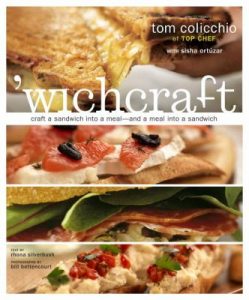 We’ll next meet on February 23 at 11 AM in the Fireplace Room. We’ll be living life between two slices of bread with Top Chef‘s Tom Colicchio’s ‘wichcraft. Copies are available at the main desk. Hope to see you there!
We’ll next meet on February 23 at 11 AM in the Fireplace Room. We’ll be living life between two slices of bread with Top Chef‘s Tom Colicchio’s ‘wichcraft. Copies are available at the main desk. Hope to see you there!
Postscript: If you’ve read all of the above, you may be wondering about the two terms I’ve used: “plant-based diet” versus “vegan.” Initially I thought they were the same thing, but a comment I overheard made me wonder if they were. A quick, and admittedly unscientific, internet search revealed the following: a plant-based diet (sometimes also called a whole-foods plant-based diet) promotes consumption of whole grains, legumes, fruits, and vegetables for health-based reasons. One can include small amounts of animal products, but the overriding emphasis is on plant-based, unprocessed foods. Vegans consume only plant-based foods, and are also ethically committed to abstaining from using animal products in any aspects of their lives– for instance, vegans do not wear leather or wool sweaters. Theoretically, vegans aren’t necessarily committed to a whole-foods approach (as many articles like to point out, Oreos and potato chips are vegan)– but this is likely more a matter of semantics than practical application. And speaking of semantics, the two terms have come to be used somewhat interchangeably, though right now “vegan” seems to be the more common usage, if only because it’s quicker to say and is understood to be shorthand for “eating only plant-based foods.” But there is a difference, and it will be interesting to see how this plays out in the coming years, especially if this type of eating continues to become more common.
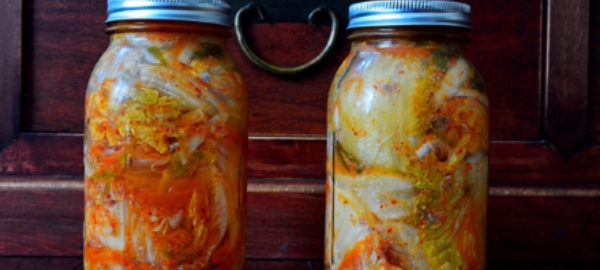
Nephew’s Kimchi – Korean Comfort Food
 Nephew is an Asianophile. Or is it Asiaphile? Though I’m not sure which term is correct, Nephew (your basic southern/eastern European mutt) greatly enjoys the cultures and foods of East Asia. He’s taught English in Taipei, Taiwan and Seoul, S. Korea, living in each for more than a year. He’s traveled in Vietnam and Thailand, and his current job takes him to China several times a year.
Nephew is an Asianophile. Or is it Asiaphile? Though I’m not sure which term is correct, Nephew (your basic southern/eastern European mutt) greatly enjoys the cultures and foods of East Asia. He’s taught English in Taipei, Taiwan and Seoul, S. Korea, living in each for more than a year. He’s traveled in Vietnam and Thailand, and his current job takes him to China several times a year.
Nephew’s living in Seoul was what first made me pay attention to Korean food; and coincidentally, it was at about that time (2012) when Korean restaurants started appearing in the Boston area. It was an adventure to wade into a cuisine which is unique and new to me, but also partially familiar as it uses some ingredients common to many Asian cultures. It was also around this time that HMart opened a store in Burlington, MA. Though there are several Asian markets in our area– there’s V-Mart in Lowell, Shin Shin in Lawrence, Chung Ge in Ayer, and M & H Oriental Food Market right here in Chelmsford– I went to HMart because I was intrigued by the idea of a Market Basket-sized store devoted to Korean food. Hmart and markets like it contain a world of food about which I knew (and still know) very little—and the lack of consistent English labeling frequently made my explorations both more puzzling and more interesting. But I’m still fascinated by the many kinds of kimchi, the innumerable types of noodles and rice, the vast stocks of gojuchang and red pepper flakes, and the array of cabbage varieties. I enjoy perusing the (to me) inscrutable labels on all kinds of shiny bags of crunchy snacks, some of which I may recognize as rice-based, but some whose contents will forever remain a mystery.
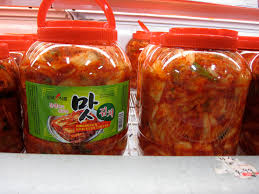 Since kimchi is one of the signature foods of Korean cuisine (probably the signature food), that was one of the things I bought at HMart, and it certainly appeared at every meal I ate in a Korean restaurant. I always tried to buy/order a mild variety, so as not set my lips on fire, but I wasn’t always successful. What Koreans think of as mild was still pretty zippy to me! At first I wasn’t even sure I liked the flavor all that much—it’s pickle-y, garlicky, spicy, and sour—but the more of it I ate, the more I came to appreciate its simple yet complex nature. And it’s like the little black dress of Korean food—it goes with everything, it can work solo or harmonize with other ingredients, and is available in many styles!
Since kimchi is one of the signature foods of Korean cuisine (probably the signature food), that was one of the things I bought at HMart, and it certainly appeared at every meal I ate in a Korean restaurant. I always tried to buy/order a mild variety, so as not set my lips on fire, but I wasn’t always successful. What Koreans think of as mild was still pretty zippy to me! At first I wasn’t even sure I liked the flavor all that much—it’s pickle-y, garlicky, spicy, and sour—but the more of it I ate, the more I came to appreciate its simple yet complex nature. And it’s like the little black dress of Korean food—it goes with everything, it can work solo or harmonize with other ingredients, and is available in many styles!
So a few months ago, I got it into my head that I wanted to make a batch of kimchi myself. I knew Nephew had tried making kimchi while in Seoul; and since he now lives in Boston I figured I could get him to help me and give me good advice about ingredients and preparation. He was up for the challenge, and we planned a Columbus Day kimchi-thon. Nephew clued me in to a blog and videos created by Maangchi, a Korean living in the US. Her explanations and photographs made the process seem easy, so off I went in quest of ingredients, almost all of which are now available in your basic large American supermarket. I did go to HMart for the essential Korean red pepper flakes and a Korean radish (though the more readily available daikon is an acceptable substitute); also some sweet rice flour, which is not sweet but is extra-starchy, and is needed to keep the kimchi from being watery.
In Korea, making kimchi can be a community affair, with friends and neighbors working together to make enough kimchi to last a family all year. Needless to say, I made a much smaller quantity; the recipe I chose is called “Easy Kimchi” on Maangchi’s website.
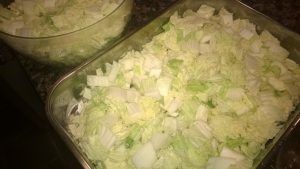
So: first, I chopped the cabbage (eight pounds worth!), and salted it thoroughly. We left it alone for a while to wilt; then drained it, rinsed it, and set it aside.
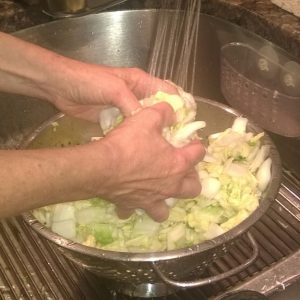
Nephew turned out to be an ace julienne-er, efficiently slivering neat piles of carrot, radish, green onions, and leek.
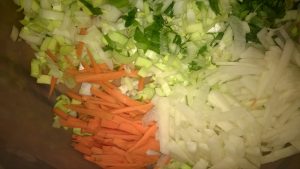
While he was chopping, I made the “porridge,” a mixture of water and sweet rice flour that is heated until thickened, like a custard. Then I added a little bit of sugar, lots of fish sauce and garlic, fresh ginger, and frightening amounts of red pepper flakes—though not nearly as much as the recipe recommended.
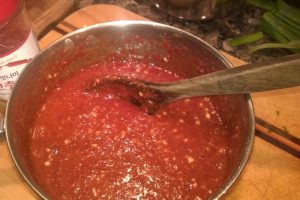 When the porridge had cooled, we combined it with Nephew’s vegetables. Finally, it was on to the big time: putting on our latex gloves (yes, the gloved hands do look a little bit creepy here!) and mixing the cabbage with the porridge and vegetables.
When the porridge had cooled, we combined it with Nephew’s vegetables. Finally, it was on to the big time: putting on our latex gloves (yes, the gloved hands do look a little bit creepy here!) and mixing the cabbage with the porridge and vegetables.
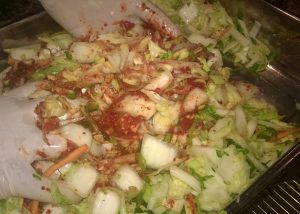
You can eat the kimchi as soon as it’s made, which we did that day; and if you don’t want it to ferment, you put it in the fridge right away.
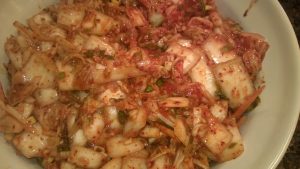
I left mine out on the counter, in a covered container, to see what would happen. After a few days, little bubbles appeared in the liquid, and we started smelling that pickle-ish, sour smell (which sounds bad but isn’t). So we knew it was fermenting; I tasted every few days to get an idea of what it was doing. I didn’t want it to get too strong, so after a couple of weeks I put it in the fridge. It will still continue to ferment, but very slowly.
That first night, I made some bibimbap and we had that with kimchi on top, though I don’t think that’s authentic. Bibimbap is another iconic Korean dish: a bowl of rice topped with various seasoned vegetables and meat and a sunnyside-up egg. You mush it all together and then slurp it up! 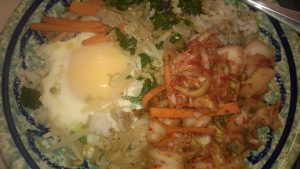 It’s comfort in a bowl and has become one of my favorite things to eat. Having homemade kimchi to go with it was just the icing on the cake, so to speak. I hope that’s OK with any Koreans who might be reading this post. Or Nephew, for that matter!
It’s comfort in a bowl and has become one of my favorite things to eat. Having homemade kimchi to go with it was just the icing on the cake, so to speak. I hope that’s OK with any Koreans who might be reading this post. Or Nephew, for that matter!
If you want to try making Korean food at home, check out some of our consortium’s titles. Note that Maangchi has now published a book—I’m going to have to take a look at that one myself.

Bibliobites in November/December: Perusing Periodicals
 It’s an embarrassment of riches when it comes to locating new or different recipes. There are infinite online resources: websites, blogs, Facebook interest groups, Tumblr posts. Can you tweet a recipe?? If you can do it in 280 characters you can! Still, many of us still enjoy the printed format, as there’s certainly no lack of books, magazines, or newspaper articles that focus on food and cooking. If we want to look up how to use a specific ingredient, or we need a certain cookie recipe stat, for the sake of speed most of us will turn to the internet. But there’s something to be said for browsing through a book or magazine and finding something scrumptious in an unexpected and serendipitous fashion. Accordingly, this month our group took on the world of periodicals both familiar and not, just to see what we would see.
It’s an embarrassment of riches when it comes to locating new or different recipes. There are infinite online resources: websites, blogs, Facebook interest groups, Tumblr posts. Can you tweet a recipe?? If you can do it in 280 characters you can! Still, many of us still enjoy the printed format, as there’s certainly no lack of books, magazines, or newspaper articles that focus on food and cooking. If we want to look up how to use a specific ingredient, or we need a certain cookie recipe stat, for the sake of speed most of us will turn to the internet. But there’s something to be said for browsing through a book or magazine and finding something scrumptious in an unexpected and serendipitous fashion. Accordingly, this month our group took on the world of periodicals both familiar and not, just to see what we would see.
Group members were free to use any periodical they preferred: old, new, food-focused or general interest. Many of us have favorites that we typically turn to, but this month gave us the opportunity to (if we chose) to find something new. An easy way to browse “print” magazines is through the library’s RBdigital (the app formerly known as Zinio). This is a quick and easy way to explore periodicals that may not be widely available in printed form– or to read an issue of a magazine when the print copy is checked out.
 One surprise for me in the general-interest category was the venerable Family Circle. Though this magazine has an old-school reputation, it’s obvious that they’ve kept up with the many changes in our cooking and eating habits. They were on-trend with a sheet pan recipe for kielbasa with cheese tortellini, and one for fish chowder! Other members tried FC’s miso sesame green beans, za’atar roasted carrots with yogurt, and curried cranberry chutney— all of which were very good. Also excellent were a Persian cauliflower rice and a sweet potato bread pudding, which turned out to be a great breakfast dish. But, sweet potato biscuits were just OK, as they didn’t have enough of their namesake flavor. They had a pretty color, though!
One surprise for me in the general-interest category was the venerable Family Circle. Though this magazine has an old-school reputation, it’s obvious that they’ve kept up with the many changes in our cooking and eating habits. They were on-trend with a sheet pan recipe for kielbasa with cheese tortellini, and one for fish chowder! Other members tried FC’s miso sesame green beans, za’atar roasted carrots with yogurt, and curried cranberry chutney— all of which were very good. Also excellent were a Persian cauliflower rice and a sweet potato bread pudding, which turned out to be a great breakfast dish. But, sweet potato biscuits were just OK, as they didn’t have enough of their namesake flavor. They had a pretty color, though!
 Good Housekeeping is another magazine that’s been around for generations; and their December issue typically features a slew of Christmas cookie recipes. One person tried their stained glass cookies, but the recipe didn’t work quite right; though the cookies looked enticing, they didn’t taste good and were tooth-breakers! My favorite GH cookie recipe is their tri-color almond slices, better known as Italian rainbow cookies. While you have to fuss a bit to make them, when finished they look appropriately fancy and taste yummy.
Good Housekeeping is another magazine that’s been around for generations; and their December issue typically features a slew of Christmas cookie recipes. One person tried their stained glass cookies, but the recipe didn’t work quite right; though the cookies looked enticing, they didn’t taste good and were tooth-breakers! My favorite GH cookie recipe is their tri-color almond slices, better known as Italian rainbow cookies. While you have to fuss a bit to make them, when finished they look appropriately fancy and taste yummy.
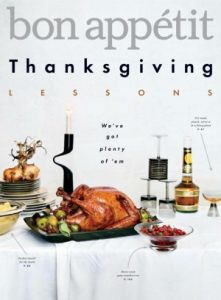 As for food-focused magazines, a few people perused Bon Appetit. Many of us remember how exciting and influential this magazine was in the 1990s, but there was general consensus that it’s just not what it used to be, and no one was enthusiastic about anything they saw in a current issue. There was a lot of talk about favorite tried-and-true BA recipes from “back then” — well-loved dishes that we continue to make today. One perennial favorite is the pumpkin cheesecake with gingersnap crust; another keeper is the penne with tomatoes, olives and two cheeses. Fine Cooking is also a magazine that’s been around for a while and those who use it think it’s as good as ever. And, the
As for food-focused magazines, a few people perused Bon Appetit. Many of us remember how exciting and influential this magazine was in the 1990s, but there was general consensus that it’s just not what it used to be, and no one was enthusiastic about anything they saw in a current issue. There was a lot of talk about favorite tried-and-true BA recipes from “back then” — well-loved dishes that we continue to make today. One perennial favorite is the pumpkin cheesecake with gingersnap crust; another keeper is the penne with tomatoes, olives and two cheeses. Fine Cooking is also a magazine that’s been around for a while and those who use it think it’s as good as ever. And, the  Food Network magazine is a popular newer choice; someone made a tasty cornbread, chorizo, and kale dressing from it. They also found a useful tip to use citrus juice to help brown poultry skin in the oven.
Food Network magazine is a popular newer choice; someone made a tasty cornbread, chorizo, and kale dressing from it. They also found a useful tip to use citrus juice to help brown poultry skin in the oven.
Two “healthy eating” magazines that we enjoyed were Cooking Light and Eating Well. Slow-cooker pork with peach preserves from CL was a good, hearty variation on pulled pork. From EW, both the pork tenderloin with white bean mash and twice-baked sweet potatoes were delicious, though the seared scallops with radicchio apple slaw was “just OK.”  The reader wished the magazine had included companion side dishes or more recipes for complete meals. Weight Watchers magazine had some good Thanksgiving-leftover recipes, including burgers, chili, soup, and turkey stock. And, Nutrition Action Newsletter (published by the Center for Science in the Public Interest) was praised for its simple recipes and no-advertising policy. Some content is available online for free.
The reader wished the magazine had included companion side dishes or more recipes for complete meals. Weight Watchers magazine had some good Thanksgiving-leftover recipes, including burgers, chili, soup, and turkey stock. And, Nutrition Action Newsletter (published by the Center for Science in the Public Interest) was praised for its simple recipes and no-advertising policy. Some content is available online for free.
Speaking of free content, Hannaford supermarket has a free magazine (OK, it’s free if you spend $25 in the store), Fresh, that several of use have used and enjoyed. Though there’s plenty of advertising for the store, there are also lots of recipes as well. If you shop there it’s definitely worth checking out.
As is always the case, our group’s discussion wandered in many directions, and led to conversation about the Instant Pot. A few in the group own one, but several people (including me) had somehow never heard of this item. It’s a multicooker that can be used as a pressure cooker, slow cooker, rice cooker, yogurt maker– and possibly more! Those who own one had high praise for it– particularly the pressure-cooking function, which significantly speeds up cooking time for dishes such as stews or dried beans which typically take hours to become tender. 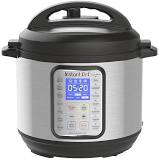 Food Network had a recipe for a Tex-Mex beef stew that was easy and tasty, and ready quickly -thanks to the Instant Pot. Though pressure-cooking certainly isn’t new, the Instant Pot has assisted in its comeback, and the pot’s safety mechanisms have assuaged people’s fears of exploding pot lids! So if Santa didn’t bring you any fun toys for Christmas, you might consider this appliance for your collection.
Food Network had a recipe for a Tex-Mex beef stew that was easy and tasty, and ready quickly -thanks to the Instant Pot. Though pressure-cooking certainly isn’t new, the Instant Pot has assisted in its comeback, and the pot’s safety mechanisms have assuaged people’s fears of exploding pot lids! So if Santa didn’t bring you any fun toys for Christmas, you might consider this appliance for your collection.
We’ll meet again on Friday, January 26 at 11 AM in the Fireplace Room. We have two titles this month, both focusing on plant-based diets: The VB6 Cookbook by Mark Bittman; and/or The Oh She Glows Cookbook by blogger Angela Liddon. Copies are available at the main desk.
A happy, healthy New Year to all!
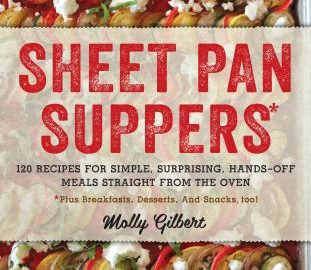
Bibliobites in October: Between the Sheets
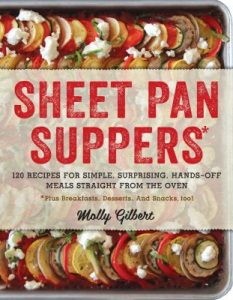 A common thread in many cookbooks both old and new is the promise of a made-from-scratch, quick and easy complete meal. Our Bibliobites group has certainly covered this territory; earlier this year we test-drove Mark Bittman’s How to Cook Everything Fast and further back, we checked out the Fix It and Forget It New Cookbook and The Make-Ahead Cook. Obviously any one of these titles have their pluses and minuses, but the lure of a fabulous yet speedy meal is a good “hook” for any cookbook! This month’s title, Sheet Pan Suppers by Molly Gilbert, treads this familiar ground and promises us that that elusive dinner solution lies in your basic pedestrian sheet pan.
A common thread in many cookbooks both old and new is the promise of a made-from-scratch, quick and easy complete meal. Our Bibliobites group has certainly covered this territory; earlier this year we test-drove Mark Bittman’s How to Cook Everything Fast and further back, we checked out the Fix It and Forget It New Cookbook and The Make-Ahead Cook. Obviously any one of these titles have their pluses and minuses, but the lure of a fabulous yet speedy meal is a good “hook” for any cookbook! This month’s title, Sheet Pan Suppers by Molly Gilbert, treads this familiar ground and promises us that that elusive dinner solution lies in your basic pedestrian sheet pan.
To be clear, let’s start with a definition: a sheet pan is nothing more than a large, rimmed metal pan approximately 18 x 13 inches, with sides usually about an inch high. If you’re a baker, this pan size is really a half-sheet pan; but here we’re dealing mostly with dinner so we’re just going to call it a sheet pan. Gilbert’s claim is that you can just pile a mess of ingredients on your pan, slip it in to the oven, and a tasty dinner will emerge in about 30 minutes. Nirvana! Can this really be true? According to our group, the answer was mostly, and perhaps even resoundingly, yes.
As far as the book itself, it’s a paperback, but a pretty good-sized one; therefore it had that all-important quality of staying open when in use. The heavy, glossy pages feature plenty of luscious photographs (now why is it, that food with charred edges always looks so scrumptious?), and many recipes are all on one page, or close to it. Most people enjoyed the author’s chatty and informative headnotes, though a few thought that sometimes her writing got a little too “cute.” Gilbert’s book contains appetizers, snacks, and desserts, though the bulk of the recipes concern main dishes. It’s worth noting that this title was published in 2014, which means the recipes were being developed at least a year or more before that. Today we think of roasting vegetables (and/or other ingredients) as basic, but when this book was created the technique was much less mainstream. In fact, lately the phrase “sheet pan dinner” seems to have become a frequent description in magazine articles and on cooking shows, so this concept has certainly moved into the realm of the everyday. As it should– since according to our group, roasting gives you a lot of bang for your buck.
Lots of sheet pans were being used, washed, and reused by the cooks in our group this past month. Most people did focus on main dishes, but a few experimented with desserts or snacks. One favorite was the quick chicken and baby broccoli with peanut sauce. The sauce was addictive as described, and melded nicely with the chicken and broccoli. Classic roast chicken with mustardy potatoes was a winner; in particular we enjoyed the combination of potatoes and Dijon mustard. Other chicken recipes we approved were the 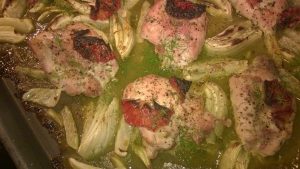 chicken legs with fennel and orange (“fantastic flavor combination”); chicken Jerome (“very easy and very good”) and the chicken Parmesan. This last came in for some criticism; the recipe called for 2 tablespoons of sweet or smoked paprika, which was an overwhelming amount. A misprint, perhaps? Overall, though, it was a good dish and the recommended jarred sauce, Rao’s, turned out to be a happy discovery.
chicken legs with fennel and orange (“fantastic flavor combination”); chicken Jerome (“very easy and very good”) and the chicken Parmesan. This last came in for some criticism; the recipe called for 2 tablespoons of sweet or smoked paprika, which was an overwhelming amount. A misprint, perhaps? Overall, though, it was a good dish and the recommended jarred sauce, Rao’s, turned out to be a happy discovery.
Other meaty mains we tried included 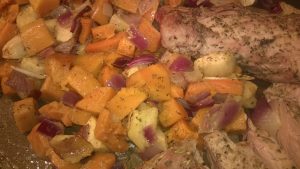 pork tenderloin with squash, apples, and onion which a few of us made and thought was a delicious and complete meal. Chinese five spice pork chops with nectarines also had praiseworthy flavor, but the recipe had a couple of oddities: brining time was listed as 4 hours up to “overnight,” which could be as much as 12 hours and would be way too long; and the ingredient list included scallions which are never mentioned in the recipe. A garnish? With nectarines being out of season, apples and pears were substituted and worked just fine. Rack of lamb with herby breadcrumbs and buttered carrots generated just one phrase: “loved it!” This is undeniably a pricey splurge, but it sounded like it was worth it! Bruce’s barbecue meatloaf and potatoes was good, but not any better than your average meatloaf recipe, and it called for “way too much” barbecue sauce: 1 1/2 cups in the loaf, and 1/2 cup on top! And finally, although a bit less meat-centric, the apple, prosciutto, and radicchio pizza was excellent and easy to make.
pork tenderloin with squash, apples, and onion which a few of us made and thought was a delicious and complete meal. Chinese five spice pork chops with nectarines also had praiseworthy flavor, but the recipe had a couple of oddities: brining time was listed as 4 hours up to “overnight,” which could be as much as 12 hours and would be way too long; and the ingredient list included scallions which are never mentioned in the recipe. A garnish? With nectarines being out of season, apples and pears were substituted and worked just fine. Rack of lamb with herby breadcrumbs and buttered carrots generated just one phrase: “loved it!” This is undeniably a pricey splurge, but it sounded like it was worth it! Bruce’s barbecue meatloaf and potatoes was good, but not any better than your average meatloaf recipe, and it called for “way too much” barbecue sauce: 1 1/2 cups in the loaf, and 1/2 cup on top! And finally, although a bit less meat-centric, the apple, prosciutto, and radicchio pizza was excellent and easy to make.
Seafood also came in for the sheet pan treatment; we liked soy-mustard salmon and broccoli and orange-ginger salmon with lentils and green beans. A couple of caveats emerged: 1) if your salmon fillets are bigger than the recipe calls for and therefore take a bit longer to cook, your broccoli will burn before the fish is done; and 2) canned lentils? Many of us had never seen this item in the supermarket, though with a little research they were located. In this latter recipe, the vegetables suffered from not being cooked enough when the fish was done. Honey-orange shrimp with baby bok choy was easy and flavorful; the bok choy was tender and the orange sauce was a good complement. It didn’t look quite as pretty as the picture in the book, though! And 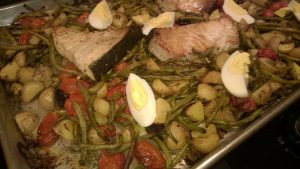 warm tuna Nicoise salad was a nice riff on the classic salad, with a yummy dressing coating loads of fresh-tasting veggies.
warm tuna Nicoise salad was a nice riff on the classic salad, with a yummy dressing coating loads of fresh-tasting veggies.
There’s also a chapter on meatless mains, and we tested a few recipes from that section as well. Baked sweet potatoes with cannellinis and baby spinach was a complete meal; colorful, tasty, and satisfying. The cute factor did come into play here: Gilbert tells you to stuff the cooked sweet potatoes with the bean filling, but this was almost impossible and just made a mess. If it had worked it would indeed have looked cute, but it was far simpler to cut up the potatoes and mix them with the other ingredients.  Lasagna’d hasselbeck potatoes suffered from a similar flaw; the potato is sort of stuffed with ricotta, mozzarella, and tomato sauce, but it was impossible to get enough filling into the potato. It was a good combination, but needed some tweaking. Roasted crisp-topped eggplant with chickpeas was “okay– it was missing something, and it seemed more like a side dish than a main.” It was definitely crispy, though, and it did make a lot so you could play around with the leftovers and change it up a bit (if you were so inspired!).
Lasagna’d hasselbeck potatoes suffered from a similar flaw; the potato is sort of stuffed with ricotta, mozzarella, and tomato sauce, but it was impossible to get enough filling into the potato. It was a good combination, but needed some tweaking. Roasted crisp-topped eggplant with chickpeas was “okay– it was missing something, and it seemed more like a side dish than a main.” It was definitely crispy, though, and it did make a lot so you could play around with the leftovers and change it up a bit (if you were so inspired!).
Phew! But wait, there’s more….crispy za’atar chickpeas were a tasty, satisfying snack, and made good use of some za’atar that had been languishing; and the herbed goat cheese and zucchini tart (which we sampled at our meeting) was both creamy and crispy….and delicious.
Let’s not forget dessert! Someone also brought in the Almond-cherry jam crostata which had a buttery shortbread crust topped with jam– a delectable combination that was quickly produced with the aid of the trusty sheet pan.  Apple galette was another pie-ish dessert that “looked really pretty and was delicious!” The amount of sugar in the recipe seemed to be excessive, but it was simple enough to use less as the sugar was sprinkled on top of the apples.
Apple galette was another pie-ish dessert that “looked really pretty and was delicious!” The amount of sugar in the recipe seemed to be excessive, but it was simple enough to use less as the sugar was sprinkled on top of the apples.
As you might infer from the number of recipes made, this was a book with broad appeal, and it did seem to live up to its claims of creating a reasonably quick and tasty dinner solution. Even if there’s significant prep involved, it was nice to know that once that pan was slid into the oven, dinner was essentially done. And many people commented that her sauces and flavor combinations were interesting and varied, and could be used in other applications.
On the down side, this book came in for a common criticism of books that focus on a particular piece of cooking equipment: not everything is best made on a sheet pan, and you sometimes feel the author is trying a bit too hard to convince you that her way is the way. So there were a few people who didn’t care for the concept of the book, even if they use a sheet pan now and then; but overall this book earned high marks from our notoriously skeptical group. Six people planned to buy the book (which may be a new record!), and our voting averaged out to 4.25 chef’s hats (out of a possible 5). Seven participants gave it a score of 5, which is also probably some kind of record for us.
There were a couple of pan recommendations if you want to try out sheet pan cooking, or need a new one: check out the Bellemain pan or the Nordic Ware. Whatever you buy, be sure it’s heavy so it doesn’t warp in the oven, and can last through years of high heat roasting and broiling.
Our next meeting will be a combined November/December meeting on Friday, December 8 at 11 AM in the Fireplace Room. Instead of a specific book, this month we’re asking everyone to choose a food magazine (new, old, yours, the library’s) and try it out. Remember you can borrow print magazines from the library, and read online as well through the library’s Zinio app.
Have a wonderful Thanksgiving, and see you December 8!
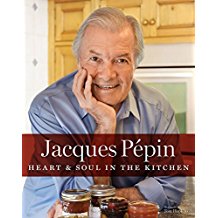
Bibliobites in September: Frère Jacques
Our September meeting brought us together on a picture-perfect fall day. It was good to see everyone after our summer break, and we welcomed some new faces as well. Since we had two titles to discuss this month, there was much to say!
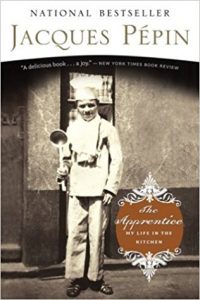 Some chefs are so well-known through their books, restaurants, and/or TV shows that we barely need a last name to identify them, and such is the case with Jacques Pépin. But where and how did he get his start? What were the experiences that shaped his life and his approach to food? These and many other questions are entertainingly explored in Pépin’s autobiography, The Apprentice. Everyone who read this book thoroughly enjoyed it. Pépin comes across as an unpretentious, hardworking regular homme who has never been afraid to try something new and different. We loved his stories about his impressively energetic mother and his gregarious father, who were able to safely shepherd their family through the danger and chaos of WWII. We were impressed by Pépin’s work ethic, as he apprenticed (without pay!) from age 13 to 16 at a restaurant in Bourg-en-Bresse. We were further impressed by his decision to leave his comfortable life as a cook in a well-regarded Paris restaurant for the unknowns of life in America. We were surprised to discover that he worked for the Howard Johnson chain for several years, improving their menu while streamlining their operations. And we’re amazed by his neverending creativity: books, TV series, cooking classes, and kitchenware line (based on his own artwork, naturellement). We decided he never sleeps!
Some chefs are so well-known through their books, restaurants, and/or TV shows that we barely need a last name to identify them, and such is the case with Jacques Pépin. But where and how did he get his start? What were the experiences that shaped his life and his approach to food? These and many other questions are entertainingly explored in Pépin’s autobiography, The Apprentice. Everyone who read this book thoroughly enjoyed it. Pépin comes across as an unpretentious, hardworking regular homme who has never been afraid to try something new and different. We loved his stories about his impressively energetic mother and his gregarious father, who were able to safely shepherd their family through the danger and chaos of WWII. We were impressed by Pépin’s work ethic, as he apprenticed (without pay!) from age 13 to 16 at a restaurant in Bourg-en-Bresse. We were further impressed by his decision to leave his comfortable life as a cook in a well-regarded Paris restaurant for the unknowns of life in America. We were surprised to discover that he worked for the Howard Johnson chain for several years, improving their menu while streamlining their operations. And we’re amazed by his neverending creativity: books, TV series, cooking classes, and kitchenware line (based on his own artwork, naturellement). We decided he never sleeps!
 Pairing The Apprentice with one of his more recent cookbooks, Heart and Soul in the Kitchen, easily enabled us to make connections between Pépin’s life and his cuisine. Many of the recipes are based on classic French dishes, but there’s often a twist; and Pépin will be the first to tell you that any recipe can and should be tweaked to suit one’s own needs and tastes. This philosophy certainly resonated with our group, none of whom is shy about altering a recipe! Though we may think of French cuisine as being labor-intensive with esoteric techniques, this book highlights simple, quick dishes that are rooted in French traditions without being hamstrung by them.
Pairing The Apprentice with one of his more recent cookbooks, Heart and Soul in the Kitchen, easily enabled us to make connections between Pépin’s life and his cuisine. Many of the recipes are based on classic French dishes, but there’s often a twist; and Pépin will be the first to tell you that any recipe can and should be tweaked to suit one’s own needs and tastes. This philosophy certainly resonated with our group, none of whom is shy about altering a recipe! Though we may think of French cuisine as being labor-intensive with esoteric techniques, this book highlights simple, quick dishes that are rooted in French traditions without being hamstrung by them.
So let’s get to the details: most of us made main dishes, since Pépin, by his own admission, is no pastry expert. Someone did make the apple galette, which uses store-bought pizza dough for the crust. This made a tasty pie; but unfortunately it’s not something that keeps well– the pizza dough got stale quickly. In dinner territory, a few of us tried fish dishes: fillet of sole Riviera with pico de gallo was exceptionally quick to prepare and had a piquant, yet creamy sauce. Cod in light cream sauce also had a simple cream-based sauce which turned out to be excellent with chicken, too! Two people tried broiled salmon with miso glaze, which was easy and delicious. However miso can still sometimes be difficult to find, or is located in odd places in the store. We tried a few pasta dishes: spaghetti with tomatoes and herbs was a disappointment– kind of boring with a sauce that was too minimal. Fusilli in spicy garlic tomato sauce was also underwhelming despite healthy amounts of garlic and red pepper flakes. Fettucine à la playa was good but a bit salty from the four ounces of anchovies! The “sauce” was really a salad-like mix of beans, olives, sun-dried tomatoes, the anchovies, and some cheese. It was a tasty combination on its own and would make a nice lunch. Also for lunch you could try the black lentil salad with eggs, which was quite good despite the inclusion of celery, which added a “weird” note. Celery then took on a starring role in the celery gratin. In the US we don’t think of celery as a cooked vegetable, but this recipe, with its Gruyère topper, was different and good. It needed a bit of crunch, though– perhaps some toasted breadcrumbs?
was exceptionally quick to prepare and had a piquant, yet creamy sauce. Cod in light cream sauce also had a simple cream-based sauce which turned out to be excellent with chicken, too! Two people tried broiled salmon with miso glaze, which was easy and delicious. However miso can still sometimes be difficult to find, or is located in odd places in the store. We tried a few pasta dishes: spaghetti with tomatoes and herbs was a disappointment– kind of boring with a sauce that was too minimal. Fusilli in spicy garlic tomato sauce was also underwhelming despite healthy amounts of garlic and red pepper flakes. Fettucine à la playa was good but a bit salty from the four ounces of anchovies! The “sauce” was really a salad-like mix of beans, olives, sun-dried tomatoes, the anchovies, and some cheese. It was a tasty combination on its own and would make a nice lunch. Also for lunch you could try the black lentil salad with eggs, which was quite good despite the inclusion of celery, which added a “weird” note. Celery then took on a starring role in the celery gratin. In the US we don’t think of celery as a cooked vegetable, but this recipe, with its Gruyère topper, was different and good. It needed a bit of crunch, though– perhaps some toasted breadcrumbs?
One person made (and brought in for us to try!) the Spanish tortilla, which we enjoyed; it’s “a good basic recipe” which you can easily vary to suit yourself; as written, the tortilla seemed a bit dry and needed something to up the flavor quotient. One recipe that really hit the mark with those who made it was the eggplant-tomato gratin, which looked “just like the picture” and was positively scrumptious (though Mr. Fussy, an avowed eggplant hater, could not be convinced to try it!). The recipe for spinach-stuffed pork loin chops was accompanied by an enticing photo, which matched its taste. The sauce was a bit runny but the whole thing was so delicious it didn’t matter. Poulet a la crème (a traditional dish from Pepin’s hometown) and chicken jardinière were both satisfying and provided a bit of a cooking lesson, as both dishes started out the exact same way but ended up completely distinct from each other.
There were, of course, some criticisms. Pépin seemed to use some ingredients repeatedly; chives, red pepper flakes, and jalapenos come to mind. A few people didn’t care for the photos; they looked too staged and some of the food appeared unnaturally shiny or wet. We noted that in both books, Pépin is not the least bit camera shy. For instance, check out the semi-naked chefs in the group of photos following page 82 of The Apprentice. That’s not really a criticism, of course– just something duly noted! Pluses of the book were its large format and friendly, relaxed tone. We felt this might be a good book to give someone learning to cook; the food is interesting and varied, gives you lots of good ideas, yet is generally pretty foolproof to make.
In the final analysis, our votes averaged out to a hair under 4 chef’s hats (out of a possible 5). That’s high praise from this group!
 Our next meeting will be on Friday, October 27 at 11 AM in the Fireplace Room; all are welcome. This month we’ll be firing up our ovens to experiment with Molly Gilbert’s Sheet Pan Suppers. From soup to nuts, Gilbert claims that this one pan can do it all– we’ll find out! Books are available at the main desk.
Our next meeting will be on Friday, October 27 at 11 AM in the Fireplace Room; all are welcome. This month we’ll be firing up our ovens to experiment with Molly Gilbert’s Sheet Pan Suppers. From soup to nuts, Gilbert claims that this one pan can do it all– we’ll find out! Books are available at the main desk.

When Life Gives You Apples……
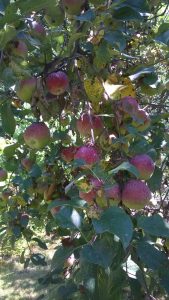 ……you make applesauce, apple butter, apple chutney, dried apples, apple tart, and apple crisp. You show up at work with bags of apples for your unsuspecting colleagues, and you leave crates of apples at the doors of your friends’ homes. And you’re thrilled when the food pantry says yes, they do accept fresh fruit. This is life in September when you’ve been blessed with an abundant apple harvest. We have four apple trees in our backyard, and this year there’s been a plethora of apples….a bonanza of apples….an avalanche of apples…..well, you get the idea! Instead of spending the warm, waning days of summer walking in the woods or even just reading a book on the back porch, we are holed up in our kitchen attempting to process the bounty that Mother Nature has bestowed. Now don’t get me wrong—it is fabulous to have these lovely raw materials, but it’s become a little too much of a good thing.
……you make applesauce, apple butter, apple chutney, dried apples, apple tart, and apple crisp. You show up at work with bags of apples for your unsuspecting colleagues, and you leave crates of apples at the doors of your friends’ homes. And you’re thrilled when the food pantry says yes, they do accept fresh fruit. This is life in September when you’ve been blessed with an abundant apple harvest. We have four apple trees in our backyard, and this year there’s been a plethora of apples….a bonanza of apples….an avalanche of apples…..well, you get the idea! Instead of spending the warm, waning days of summer walking in the woods or even just reading a book on the back porch, we are holed up in our kitchen attempting to process the bounty that Mother Nature has bestowed. Now don’t get me wrong—it is fabulous to have these lovely raw materials, but it’s become a little too much of a good thing.
Our primary product this year is, as always, applesauce. Most of it I freeze; some of it I preserve. Applesauce is easy to make and has the virtue of using a goodly amount of apples. I always thought applesauce was boring and tasteless until I started making my own. Smooth and rich, intensely apple-y and lip-smackingly delicious, homemade applesauce is autumn in a bowl. It can also be endlessly varied with different (or no) sweeteners, spices, and textures (smooth or chunky). You can also cook down your applesauce into apple butter, a tart and tasty spread that can be spread on just about anything, or used to make a glaze for chicken or pork. 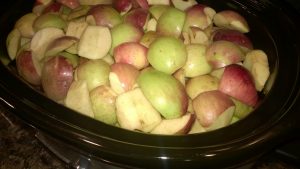 This year, for the first time, I tried making applesauce in my slow cooker. While it doesn’t have the capacity of my largest pot, it does have the virtue of not needing much attention during the cooking process. I load up the cooker with cored, quartered apples, crank it up to “high” and let it cook for around 4 hours, stirring every hour or so. By then the apples have broken down into a chunky mass, but aren’t fully cooked.
This year, for the first time, I tried making applesauce in my slow cooker. While it doesn’t have the capacity of my largest pot, it does have the virtue of not needing much attention during the cooking process. I load up the cooker with cored, quartered apples, crank it up to “high” and let it cook for around 4 hours, stirring every hour or so. By then the apples have broken down into a chunky mass, but aren’t fully cooked.  So the next step is to partially uncover the pot and let it cook further while evaporating some of the liquid. This can take another 5 or 6 hours; but again, it requires little attention from me. When I think it’s thick enough, I run it through my ancient food mill (inherited from my mother-in-law), and add sweetener if I feel so inclined.
So the next step is to partially uncover the pot and let it cook further while evaporating some of the liquid. This can take another 5 or 6 hours; but again, it requires little attention from me. When I think it’s thick enough, I run it through my ancient food mill (inherited from my mother-in-law), and add sweetener if I feel so inclined.  It’s true you have to be kind of hanging around to keep one eye on the pot, but as I’ve already mentioned, I’m pretty much chained to my stove and sink dealing with apples; so the slow cooker method is convenient for me.
It’s true you have to be kind of hanging around to keep one eye on the pot, but as I’ve already mentioned, I’m pretty much chained to my stove and sink dealing with apples; so the slow cooker method is convenient for me.
Several years ago we bought a dehydrator to help us in our quest to preserve the harvest, and this year it’s been running pretty much nonstop. Dried apples are always welcome in granola or cookies or muffins. They also feature in a fantastic pie that I love to make at Thanksgiving. My sister gave me this recipe, which I believe is of Pennsylvania Dutch origin:
Schnitz Pie
1/2 lb. dried apples 2 C. cold water 1 T. grated orange peel 1/4 C. orange juice 1/2 t.cinnamon 1/2 t. nutmeg 1/4 t. salt 1 C. sugar pastry for one or two crust pie Combine apples and water in large saucepan. Cover and cook over low heat about 15 minutes, or until tender. Stir in remaining ingredients, allow to cool. Heat oven to 425 degrees. Line shallow 9" pie pan with crust and pour filling into crust. Cover with top crust if desired; seal, flute, and cut steam vents. Bake 40-45 minutes. Cover crust edge with foil if excessive browning occurs.
My husband, the chief orchardist, also likes to make what he calls “apple chips.” After dehydrating, he crisps the apple slices in a low oven. They make fairly addictive snacks and are especially yummy with cheese. Not to mention they keep well for months.
 This year our lone peach tree has, for the first time, produced significant numbers of peaches. The dehydrator’s been a big help here, too. We’re still learning the ins and outs of drying peaches but so far we’ve at least produced something edible. It’s a lot harder to get nice, even slices from a peach than from an apple, but I’m sure we’ll eventually work out a system. I’ve also made a few batches of peach butter (this time using my oven) which beautifully concentrates that sweet, peachy flavor. And it uses up a lot of peaches! The recipe I used comes from Food in Jars, a popular book by blogger Marisa McLellan. And, I’ve made one batch of peach salsa and plan to make more; a coworker gave me a flavorful, not-too-spicy recipe from the Ball Complete Book of Home Preserving. The instructions call for a fair amount of chopping, but once that’s done the rest is quick and easy. And we certainly enjoy consuming the result with chips, as a sauce for chicken, or in pork tacos.
This year our lone peach tree has, for the first time, produced significant numbers of peaches. The dehydrator’s been a big help here, too. We’re still learning the ins and outs of drying peaches but so far we’ve at least produced something edible. It’s a lot harder to get nice, even slices from a peach than from an apple, but I’m sure we’ll eventually work out a system. I’ve also made a few batches of peach butter (this time using my oven) which beautifully concentrates that sweet, peachy flavor. And it uses up a lot of peaches! The recipe I used comes from Food in Jars, a popular book by blogger Marisa McLellan. And, I’ve made one batch of peach salsa and plan to make more; a coworker gave me a flavorful, not-too-spicy recipe from the Ball Complete Book of Home Preserving. The instructions call for a fair amount of chopping, but once that’s done the rest is quick and easy. And we certainly enjoy consuming the result with chips, as a sauce for chicken, or in pork tacos.
As some of you know, I work in the children’s room at the library. There’s a classic picture book called Millions of Cats (written in 1928) which has a rhythmic refrain that I often find myself thinking of as I wash yet another overflowing sinkful of apples. With apologies to author Wanda Gag, I have “…Hundreds of apples/Thousands of apples/Millions and billions and trillions of apples!”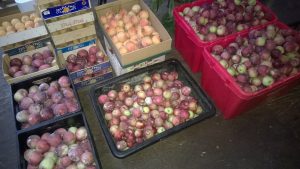
But I guess millions of apples is better than millions of cats. Happy fall, everyone!
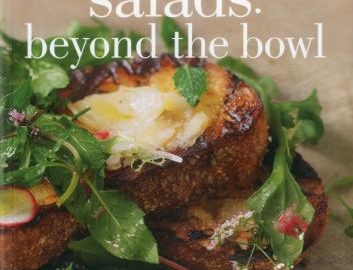
Bibliobites in June: Super Summery Supper Salads
Warm sunny days are here, and who wants to spend them standing over a hot stove? Wouldn’t you rather put together a cool, crunchy, savory meal of greens or grains or pasta complemented by a freshly made tangy dressing? Main-dish salads are a (mostly!) quick and delicious solution for hot-weather meals, and our two titles this month explored salads both familiar and innovative.
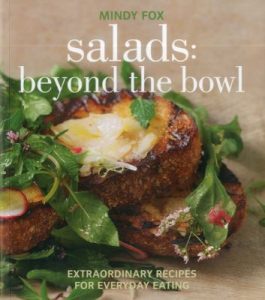 Mindy Fox’s Salads: Beyond the Bowl includes salads that are meant as sides, plus those that are hefty enough to go solo for dinner. We all noted the many drool-worthy photographs, and liked that most recipes were on one page. Alas, the binding on my copy was so tight that the book wouldn’t stay open by itself, though time and use will take care of that problem! In general we thought the recipes were a bit fussy and labor-intensive, though the end result was usually quite good. For some reason, I think we associate “salad” with “simple and quick,” so it was a mental shift to realize that with this book we’d need to spend more time creating (if not actually cooking) the salad and its components. Among the simpler recipes we tried were the blueberries, feta, and mint, an unusual combination that was unexpectedly delicious. Also different,
Mindy Fox’s Salads: Beyond the Bowl includes salads that are meant as sides, plus those that are hefty enough to go solo for dinner. We all noted the many drool-worthy photographs, and liked that most recipes were on one page. Alas, the binding on my copy was so tight that the book wouldn’t stay open by itself, though time and use will take care of that problem! In general we thought the recipes were a bit fussy and labor-intensive, though the end result was usually quite good. For some reason, I think we associate “salad” with “simple and quick,” so it was a mental shift to realize that with this book we’d need to spend more time creating (if not actually cooking) the salad and its components. Among the simpler recipes we tried were the blueberries, feta, and mint, an unusual combination that was unexpectedly delicious. Also different, 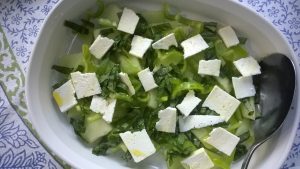 green melon, cubanelle peppers, and ricotta salata offered a welcome, subtle riff on the better-known watermelon/feta salad. On the plate, it had a cool, pale-green presentation and was mild yet flavorful. The tender carrots with miso and tahini were quick to make if you bought pre-shredded carrots, or have a food processor; the dressing with its Asian flavors brought new life to what many think of as a boring vegetable.
green melon, cubanelle peppers, and ricotta salata offered a welcome, subtle riff on the better-known watermelon/feta salad. On the plate, it had a cool, pale-green presentation and was mild yet flavorful. The tender carrots with miso and tahini were quick to make if you bought pre-shredded carrots, or have a food processor; the dressing with its Asian flavors brought new life to what many think of as a boring vegetable.
Moving closer to the main dish department, the potato salad with charred poblano peppers, sweet corn, and crema had a fair amount of prep; but the combination had lots of zip, and made enough for more than one meal. The freekeh salad with fava beans, grilled asparagus, and roasted lemon was easily a meal in a bowl, though peas had to be substituted for the fresh fava beans, which are difficult to find. This salad was hearty but not heavy, and made great lunch leftovers. Sometimes a recipe gives you too much of a good thing, as was the case with the 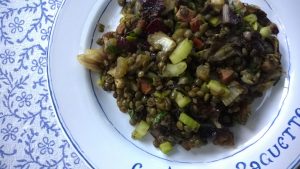 lentils, grilled radicchio, and chorizo. The recipe called for a pound of radicchio (a whole head), which made the resulting salad quite bitter. Once much of it was picked out, the remaining combination of lentils, celery, chorizo, and some radicchio was tasty; and it aged well. Frisee and cucumber salad with mexican-spiced pork and guacamole was a harmonious combination of sliced grilled pork atop greens, with a tart and flavorful guacamole on the side.
lentils, grilled radicchio, and chorizo. The recipe called for a pound of radicchio (a whole head), which made the resulting salad quite bitter. Once much of it was picked out, the remaining combination of lentils, celery, chorizo, and some radicchio was tasty; and it aged well. Frisee and cucumber salad with mexican-spiced pork and guacamole was a harmonious combination of sliced grilled pork atop greens, with a tart and flavorful guacamole on the side. 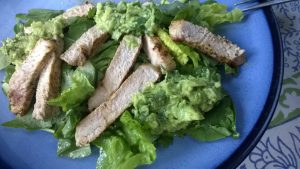 Frisee proved difficult to find, but any crisp green can be substituted. Though there were three separate components, this dish was fairly quick to make– a virtue we always appreciate! Warm shrimp salad with Indian-spiced lentils, yogurt and pepitas was a winner, though lentils were swapped out in favor of a combination of chickpeas and kidney beans. This recipe had plenty of spice without being overpoweringly hot, and its varied textures kept things interesting.
Frisee proved difficult to find, but any crisp green can be substituted. Though there were three separate components, this dish was fairly quick to make– a virtue we always appreciate! Warm shrimp salad with Indian-spiced lentils, yogurt and pepitas was a winner, though lentils were swapped out in favor of a combination of chickpeas and kidney beans. This recipe had plenty of spice without being overpoweringly hot, and its varied textures kept things interesting.
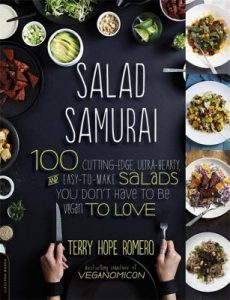 Our other title for the month, Salad Samurai by Terry Hope Romero, proved a bit more intimidating for most people. Romero is a well-known vegan chef with several cookbooks to her credit. So Samurai makes plentiful use of tofu and beans (since the recipes are designed to be main dishes), and of course uses no meat, eggs, or dairy. These considerations sometimes necessitated extra prep time, and if you don’t like tofu or beans, you’re out of luck. Like Fox’s, this book also features delectable photos; and Romero’s trademark enthusiastic and humorous writing makes for an enjoyable read. There were some complaints about inconsistent editing, and that all-too-common situation where the photo (however lovely) doesn’t match its recipe. But those brave enough to venture into tofu territory came back with good reports: strawberry spinach salad with orange poppyseed dressing had really wonderful flavors, as did the asparagus pad thai. Both were somewhat labor-intensive, requiring prep for the tofu itself (pressing and then cooking in advance), dressing, vegetables, and nut toppers. The flavors of east-west corn salad were also delectable, and like most of the recipes tried from this book, it made a substantial quantity. Monday night red beans and rice salad was good, but perhaps more ordinary than many of the other recipes in the book; it didn’t stand out in any particular way, though at least it was fairly quick to prepare.
Our other title for the month, Salad Samurai by Terry Hope Romero, proved a bit more intimidating for most people. Romero is a well-known vegan chef with several cookbooks to her credit. So Samurai makes plentiful use of tofu and beans (since the recipes are designed to be main dishes), and of course uses no meat, eggs, or dairy. These considerations sometimes necessitated extra prep time, and if you don’t like tofu or beans, you’re out of luck. Like Fox’s, this book also features delectable photos; and Romero’s trademark enthusiastic and humorous writing makes for an enjoyable read. There were some complaints about inconsistent editing, and that all-too-common situation where the photo (however lovely) doesn’t match its recipe. But those brave enough to venture into tofu territory came back with good reports: strawberry spinach salad with orange poppyseed dressing had really wonderful flavors, as did the asparagus pad thai. Both were somewhat labor-intensive, requiring prep for the tofu itself (pressing and then cooking in advance), dressing, vegetables, and nut toppers. The flavors of east-west corn salad were also delectable, and like most of the recipes tried from this book, it made a substantial quantity. Monday night red beans and rice salad was good, but perhaps more ordinary than many of the other recipes in the book; it didn’t stand out in any particular way, though at least it was fairly quick to prepare.
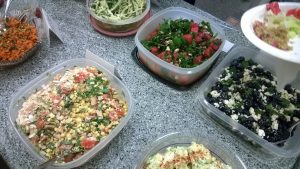 Since this was our last meeting until September, we ended the morning with a potluck lunch featuring several of the recipes discussed above. It was wonderful to be able to taste such a variety of salads; many thanks to all who took the time and trouble to contribute. Two members brought dessert as well (hooray!); here’s a link for the limoncello ricotta cheesecake we all enjoyed.
Since this was our last meeting until September, we ended the morning with a potluck lunch featuring several of the recipes discussed above. It was wonderful to be able to taste such a variety of salads; many thanks to all who took the time and trouble to contribute. Two members brought dessert as well (hooray!); here’s a link for the limoncello ricotta cheesecake we all enjoyed.
Though people stated that they liked the salads they tried (and one person liked Salad Samurai so much that she bought it!), voting reflected a bit of ambivalence. A few people live with a Mr. Fussy who isn’t fond of salads, which limited experimentation with the books, while others were put off by the time and planning ahead required for some of the recipes. There was general consensus that the flavors and combinations presented were worth the trouble, if you had the time and inclination. So, ultimately both books averaged out to a 3 (out of a possible 5) chef’s hats rating, though that overall number disguises some vast differences of opinion. That’s statistics for you!
Thank you to everyone for your participation over the past year. Your opinions, comments, and sage advice are always enjoyed and appreciated. Our next meeting will be September 30 at 11 AM in the Fireplace Room; all are welcome to join us. Enjoy your summer, don’t spend too much time in the kitchen, and see you in the fall!
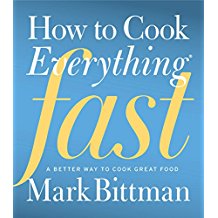
Bibliobites in May: Beat the Clock!
 Especially on a weeknight, the appeal of “fast” is undeniable. We all would like a fresh, home-cooked meal at the end of a long day; but we often don’t have the time for the kinds of prep a from-scratch dish requires. Author Mark Bittman promises to show us how to cook so efficiently that we can have dinner on the table in 30 minutes, without using any prepared or shortcut ingredients. And he claims his food will taste as good, or better, than more traditional versions that require much more time to execute. Can Bittman (master of several Everything books) deliver on this bold promise?
Especially on a weeknight, the appeal of “fast” is undeniable. We all would like a fresh, home-cooked meal at the end of a long day; but we often don’t have the time for the kinds of prep a from-scratch dish requires. Author Mark Bittman promises to show us how to cook so efficiently that we can have dinner on the table in 30 minutes, without using any prepared or shortcut ingredients. And he claims his food will taste as good, or better, than more traditional versions that require much more time to execute. Can Bittman (master of several Everything books) deliver on this bold promise?
Problem number one: this book is a tome! Not counting the indexes, it’s just over 1000 pages. It’s a big heavy book that can be a bit of a chore to lug around; though considering its thickness it’s lighter than it could have been. It’s sized so that its pages do stay open on the counter (unless you’re at the very beginning or end)– always appreciated. 
But unlike many other recent (2014) cookbooks, this one features no photographs! The beginning chapters, which provide information on cooking efficiently, do have plenty of line drawings to illustrate various techniques, a style reminiscent of The Joy of Cooking from the ’70s. That’s not necessarily a criticism; this book just has a very different style from the lavishly photographed titles that have become the norm over the past ten years. The font and layout of the pages made it easy to read the recipes. We liked that Bittman repeated the quantity when telling you to add an ingredient, which eliminated a lot of glancing back-and-forth for the reader. He also has prep steps printed in blue, and cooking instructions in black; some liked this feature, others found it distracting. At the end of each recipe, Bittman lists several variations on the initial recipe; this was very helpful as you could adjust based on ingredients you might have on hand.
The first 40 pages of the book are called “How to Cook,” and provide lots of information on how to efficiently slice, dice, chop, and more. He also lists pantry ingredients to have on hand, ideas on how to set up your kitchen workspace, and general strategies for speeding up your meal preparation. All of us learned a thing or two, and also realized that many of the ideas listed we had arrived at ourselves through trial and error. So we felt this book might be especially useful for someone without a lot of kitchen experience.
Problem number two: most of us apparently are way too slow! Bittman often tells you to chop something while your oil or butter is heating in the pan; but rarely could we complete the task before the pan got a bit too hot. This seemed to happen with other steps as well, where the prep step in the middle of a cooking step took longer than predicted. Obviously you can turn down the heat or set something aside until your prep is done, but this sort of precision timing made for a more stressful experience in the kitchen. Some of us ignored the order of prep and just did certain steps well ahead of time, which certainly works if you have that time available, but sort of defeats the purpose of the book’s philosophy! However, as Bittman himself might point out, the best way to do something is the way that works for you. And when we got right down to it, most of the time claims were pretty on target; recipes that were supposed to take 30 minutes generally were in the 30-40 minute range. A few came in under 30 minutes! Forty-five minute recipes were often quite close to that.
But what really counts in any cookbook is the food itself; and though most of the recipes were quick as claimed, were they tasty as well? Read on…..the sesame chicken with snow peas was good, but not great; it did take the 30 minutes predicted. The eggplant Parm sub likewise wasn’t overly impressive, but the idea of it was solid and with some future tweaking it might be a keeper. Similarly, the pasta with spicy eggplant and tomato sauce was OK but not inspiring. The caramel-cooked cod was super-salty; the dish was dominated by fish sauce and lacked the balance between sweet and salty that’s the hallmark of this classic recipe. Chicken and spinach meatloaf was on the bland side and unfortunately didn’t reheat that well, and the scallion pancakes needed a bit more salt. But they were very fast! The stir-fry noodles with beef and celery were also very quick, but “boring.” Fennel salad was good and pleasantly simple, but “I still like Ina Garten’s recipe better!” The spaghetti and drop meatballs were tasty, but the timing was a bit tricky– by the time you dropped the final meatballs into the sauce, the first ones were already done, so it was hard to cook everything evenly. And it didn’t seem like dropping the meatballs vs. rolling them saved that much time. Cold peanut noodles were “OK,” but fast, and “I would make them again.” The Moroccan-spiced chicken cutlets could’ve used more sauce, but the touch of cinnamon was different and enjoyable.
Other chicken recipes that we tried and liked were the chicken with creamed spinach (“really moist”), chicken and cauliflower curry with apricots (the variation with tomatoes instead of apricots), honey-ginger-soy roasted chicken and celery (“very good flavor”), and the mushroom and chicken stew with dill and paprika (“easy and flavorful– love the dill!”). We tried a few fish dishes as well; the blackened catfish with green beans (the Dijon mustard variation) was quick, though the green beans really needed more time. The recipe seemed to have “too much” butter; the sole with glazed carrots also used a fair amount of butter, but it was delicious as written, and was a nice one-pan meal.
We appreciated that Bittman keeps his suggestions for sides super-simple; often just warm bread, plain rice, or noodles. Most recipes incorporate plenty of vegetables, which we liked, and his vegetarian section is clearly not an afterthought. His recipes use almost all fresh ingredients (with a few exceptions, like canned tomatoes), which is admirable but could get a bit carried away for our tastes. For instance, he called for an orange when what was needed was orange juice, and only 3 tablespoons at that. It’s hard to believe the fresh-squeezed juice would make a noticeable difference. Similarly he normally calls for fresh spinach (with all the washing and trimming that entails) when sometimes frozen would have done just fine. But this is every cook’s own decision! Some thought the recipes sacrificed too much flavor in the pursuit of quickness; others noted an over- reliance on red pepper flakes to boost flavor. And the bakers among us were disappointed that the dessert chapter was very short and didn’t feature many baked goods, many of which would be over the 45 minute time limit. Guess you just can’t have it all!
Many of us already have our go-to recipes when we want a speedy meal, but this book did give us some good ideas, and some new ways to think about our cooking process. Most people rated this book 4 chef’s hats (out of a possible 5), but there were enough unimpressed cooks that the overall average was 3.25. There’s no grade inflation with this group, though, so 3.25 is a pretty good mark!
 Our last meeting until September will be on Friday, June 30 at 11 AM in the McCarthy room. We have 2 titles this month: Salads: Beyond the Bowl by Mindy Fox; or Salad Samurai by Terry Hope Romero. This meeting will feature a potluck lunch; bring an (optional) salad to share, either from the books or one of your tried-and-true favorites. All are welcome, please join us!
Our last meeting until September will be on Friday, June 30 at 11 AM in the McCarthy room. We have 2 titles this month: Salads: Beyond the Bowl by Mindy Fox; or Salad Samurai by Terry Hope Romero. This meeting will feature a potluck lunch; bring an (optional) salad to share, either from the books or one of your tried-and-true favorites. All are welcome, please join us!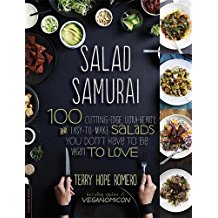

Postcards From Portland
 …..Portland, Oregon, that is! I’m here on vacation visiting my brother and sister-in-law, and as is often the case when I’m traveling, I’m checking out the local food scene. Coincidentally enough, on our first day here, my sister-in-law held up a cookbook and said, “Look at this great salad book I just picked up at the library! I’ve already marked so many recipes to try!” It was Salads: Beyond the Bowl, one of our June Bibliobites selections! I guess we all have produce on the brain at this time of year.
…..Portland, Oregon, that is! I’m here on vacation visiting my brother and sister-in-law, and as is often the case when I’m traveling, I’m checking out the local food scene. Coincidentally enough, on our first day here, my sister-in-law held up a cookbook and said, “Look at this great salad book I just picked up at the library! I’ve already marked so many recipes to try!” It was Salads: Beyond the Bowl, one of our June Bibliobites selections! I guess we all have produce on the brain at this time of year.
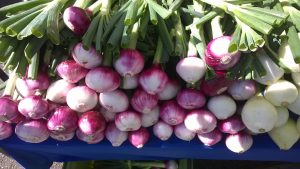 On Saturday we went to the Beaverton Farmers’ Market. This is one of the largest outdoor markets in the area, and features local produce, meat, cheese, bread, wine, specialty foods and more. We saw plenty of salad greens of all types; lots of spring onions,
On Saturday we went to the Beaverton Farmers’ Market. This is one of the largest outdoor markets in the area, and features local produce, meat, cheese, bread, wine, specialty foods and more. We saw plenty of salad greens of all types; lots of spring onions,  French radishes, and best of all– local strawberries!
French radishes, and best of all– local strawberries! We also brought home two types of aged goat cheese, some bagels, and a marionberry (similar to blackberry) pie. Many of the vendors had samples of their food available; my favorite was a fresh Mexican chorizo, which is hard to find in our area. I may have to pack some in my luggage for the trip home! All in all it was a morning of gorgeous colors, textures, and tastes.
We also brought home two types of aged goat cheese, some bagels, and a marionberry (similar to blackberry) pie. Many of the vendors had samples of their food available; my favorite was a fresh Mexican chorizo, which is hard to find in our area. I may have to pack some in my luggage for the trip home! All in all it was a morning of gorgeous colors, textures, and tastes.
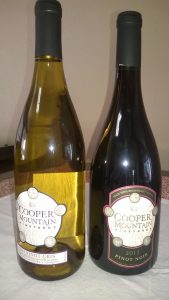 Sunday brought another warm and sunny day, so we spent a good portion of the afternoon at a local winery called Cooper Mountain. The Willamette Valley (where Portland is located) is home to hundreds of wineries; most produce pinot noir and pinot gris. Cooper Mountain has the virtue of being less than 30 minutes from my brother’s house, so that’s where we went. We tried a few different styles of pinot noir, a pinot gris, and a rose blend, all eminently drinkable! We were able to sit outside near the rustling grapevines, and sip our wine in the shade while enjoying views of the Coast range to our west, Cooper Mountain being at the top of a (very small) mountain. Again I was debating what I could stuff in my suitcase for the trip home, but I think we may just consume what we can while here. There’s always the next trip!
Sunday brought another warm and sunny day, so we spent a good portion of the afternoon at a local winery called Cooper Mountain. The Willamette Valley (where Portland is located) is home to hundreds of wineries; most produce pinot noir and pinot gris. Cooper Mountain has the virtue of being less than 30 minutes from my brother’s house, so that’s where we went. We tried a few different styles of pinot noir, a pinot gris, and a rose blend, all eminently drinkable! We were able to sit outside near the rustling grapevines, and sip our wine in the shade while enjoying views of the Coast range to our west, Cooper Mountain being at the top of a (very small) mountain. Again I was debating what I could stuff in my suitcase for the trip home, but I think we may just consume what we can while here. There’s always the next trip!
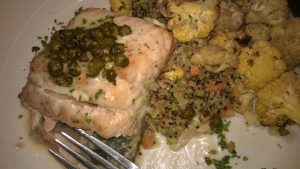 We had decided to take a short side trip to Bend, Oregon which is east of the Cascade Mountains. This central part of the state is much drier than the Portland area (it’s a “high desert” area), and is home to lakes, rivers, and mountains which provide endless recreational opportunities. From a food standpoint, one of the local favorites is trout, which I sampled in two forms while there– a smoked trout spread for an appetizer, and steelhead trout for my main course. The spread was chunky with lots of delicately smoky fish, while the steelhead was rich and salmon-y and perfectly fresh; it was complemented by a lemon and caper sauce.
We had decided to take a short side trip to Bend, Oregon which is east of the Cascade Mountains. This central part of the state is much drier than the Portland area (it’s a “high desert” area), and is home to lakes, rivers, and mountains which provide endless recreational opportunities. From a food standpoint, one of the local favorites is trout, which I sampled in two forms while there– a smoked trout spread for an appetizer, and steelhead trout for my main course. The spread was chunky with lots of delicately smoky fish, while the steelhead was rich and salmon-y and perfectly fresh; it was complemented by a lemon and caper sauce.
 Berries are everywhere in the Northwest; they grow well in the area’s sunny, dry summers. Wild blackberries appear in embarrassing profusion just about anywhere there’s a patch of soil; so it’s no surprise that many restaurant dishes feature them and their kin. A fruit cup here would be unthinkable without berries, so predictably my breakfast of lemony ricotta pancakes came topped with raspberries and blueberries. Admittedly they couldn’t be local at this time of year, but they were delicious all the same. Local berries of all sorts will be everywhere in July, so it looks like I’ll miss that this year. Perhaps I can get my sister-in-law to make some jam and send it to me!
Berries are everywhere in the Northwest; they grow well in the area’s sunny, dry summers. Wild blackberries appear in embarrassing profusion just about anywhere there’s a patch of soil; so it’s no surprise that many restaurant dishes feature them and their kin. A fruit cup here would be unthinkable without berries, so predictably my breakfast of lemony ricotta pancakes came topped with raspberries and blueberries. Admittedly they couldn’t be local at this time of year, but they were delicious all the same. Local berries of all sorts will be everywhere in July, so it looks like I’ll miss that this year. Perhaps I can get my sister-in-law to make some jam and send it to me!
Portland was one of the pioneers in the food truck scene; here they are called “food carts” and they are permanent structures that don’t move. We visited our favorite pod of food carts downtown, in quest of Bing Mi’s Chinese crepe. This is a large,thin, eggy pancake rolled around a filling of veggies, your choice of meat, and the fabulous, addictive secret sauce. 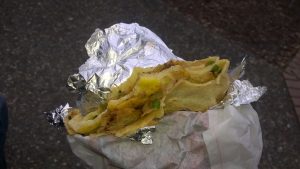 They’re made to order, and on a cool and cloudy day this steamy, flavorful lunch really hit the spot. I’d devoured more than half of it when I realized I’d forgotten to take the requisite photo! This was all that was left when I finally remembered.
They’re made to order, and on a cool and cloudy day this steamy, flavorful lunch really hit the spot. I’d devoured more than half of it when I realized I’d forgotten to take the requisite photo! This was all that was left when I finally remembered.
 One of Portland’s most famous treats is Voodoo Doughnuts. This small downtown shop is open 24 hours a day and has a perpetual line out the door. On previous visits we’ve been discouraged by waits of an hour or more, but this year as we strolled by, we noticed that the line was unusually short. As it turned out, we only had to wait for 15 minutes or so; and in fact we had trouble making our choices before we arrived at the counter. One of Voodoo’s claims to fame is their unusual flavors– for instance, we tried the popular maple-bacon bar, a rectangular donut with maple frosting and a strip of bacon across the top. And the voodoo donut, which is your basic jelly donut, but it’s shaped like its namesake and has a pretzel stake sticking out of its tummy! We also bought a donut with a hibiscus glaze, and a plain glazed to judge against hometown Dunkin’s.
One of Portland’s most famous treats is Voodoo Doughnuts. This small downtown shop is open 24 hours a day and has a perpetual line out the door. On previous visits we’ve been discouraged by waits of an hour or more, but this year as we strolled by, we noticed that the line was unusually short. As it turned out, we only had to wait for 15 minutes or so; and in fact we had trouble making our choices before we arrived at the counter. One of Voodoo’s claims to fame is their unusual flavors– for instance, we tried the popular maple-bacon bar, a rectangular donut with maple frosting and a strip of bacon across the top. And the voodoo donut, which is your basic jelly donut, but it’s shaped like its namesake and has a pretzel stake sticking out of its tummy! We also bought a donut with a hibiscus glaze, and a plain glazed to judge against hometown Dunkin’s.
 Voodoo has instantly identifiable packaging– we saw many people strolling proudly about with their bright pink boxes. Though Voodoo is a longstanding Portland tradition, and has been written up in probably every food magazine you can think of, we didn’t think the donuts quite lived up to the hype (though of course we had no difficulty in polishing them off). For my money, the best donuts are cider donuts you can find in the fall at almost any farm stand, or if you want a road trip to the original Portland (in Maine), try the yummy potato donuts at The Holy Donut.
Voodoo has instantly identifiable packaging– we saw many people strolling proudly about with their bright pink boxes. Though Voodoo is a longstanding Portland tradition, and has been written up in probably every food magazine you can think of, we didn’t think the donuts quite lived up to the hype (though of course we had no difficulty in polishing them off). For my money, the best donuts are cider donuts you can find in the fall at almost any farm stand, or if you want a road trip to the original Portland (in Maine), try the yummy potato donuts at The Holy Donut.
I haven’t even touched on the extensive craft brewery scene here, or the fantastic coffee I drank everywhere; both of these items are so ubiquitous that a local wouldn’t even think about it. My favorite part of being in Portland is getting to see my family– but the excellent and diverse food scene here is certainly a bonus!
Fun fact: Portland was named with a coin toss. The two main founders of the city, Francis Pettygrove and Asa Lovejoy, were from (respectively) Portland, ME and Boston, MA. They agreed that whoever won the two-out-of-three toss could name the new city after their hometown. Guess who won? Even more fun fact for me: I recently discovered that Asa Lovejoy is one of my husband’s ancestors!






